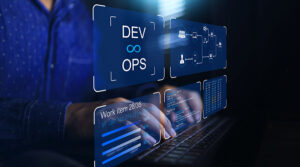Did you know that companies using DevOps can push out software updates 200 times faster than others? This speed helps them keep up with changing customer needs. But how do they keep everything safe and high-quality while moving so fast? It’s all thanks to continuous monitoring in the DevOps process.
In this article, we discuss continuous monitoring and its importance in DevOps, its types and benefits, and how enrolling in a DevOps course can help you excel in crucial DevOps tools and techniques.
What Do We Mean by Continuous Monitoring?
Companies must update their software quickly to meet customers’ needs. DevOps combines development and operations to make this process faster and more efficient. Continuous monitoring is a vital part of this.
Continuous monitoring is an automated system that helps identify and fix compliance and security problems in the DevOps process. As more applications move to the cloud, robust security is essential. Continuous monitoring tracks systems in real time, identifying errors and threats early. This ensures the software follows rules and regulations during every stage of the development and deployment process.
Continuous monitoring isn’t limited to DevOps; it applies to any area that needs monitoring. It monitors metrics across various environments—on-premise, cloud, or containers—allowing quick error detection and decision-making. It serves as a vigilant monitor, notifying teams immediately about security breaches or operational issues as they arise.
DevOps engineers rely on tools like Prometheus, Monit, Datadog, and Nagios to constantly oversee systems, ensuring that issues are swiftly detected and resolved. Continuous monitoring strengthens security, boosts incident response, and offers insights into IT system health. By adopting this proactive approach, teams can address problems promptly, ensuring smooth software delivery and robust security.
Also Read: What is Docker Container? Steps to Use It and Its Benefits
Goals of Continuous Monitoring in DevOps
Continuous monitoring is essential for maintaining security, performance, and user satisfaction in IT environments. Here are the key goals of continuous monitoring:
Enhancing Transparency and Visibility
Continuous monitoring boosts transparency and visibility in IT and network operations. Monitoring these areas closely, especially those vulnerable to security breaches, helps spot and address potential threats quickly. A timely alert system ensures issues are dealt with before they escalate into major problems.
Monitoring Software Performance
One key goal of continuous monitoring is to detect and fix performance issues. It identifies the root causes of errors and swiftly applies solutions, protecting uptime and revenue. This proactive approach maintains consistent service quality and reduces downtime, essential for keeping businesses running smoothly.
Tracking User Behavior
It also tracks user behavior, particularly after updates to applications or websites. It assesses how these updates affect user experience—positively, negatively, or neutrally. This insight allows businesses to refine their strategies, improving customer satisfaction and retention.
Ensuring Quality During Production Release
Continuous monitoring quickly alerts quality analysts to any issues during production releases. This fast feedback allows for immediate fixes, keeping the production environment stable and secure.
Supporting Root-Cause Analysis
Real-time data from continuous monitoring helps teams understand user interactions and the overall experience. This information is crucial for determining what caused problems and assessing the performance of IT systems and software.
Strengthening Business Strategies
It supports companies in building and enhancing their business strategies by tracking user feedback and interactions post-update. This feedback loop ensures updates meet user expectations and improve overall business performance.
Types of Continuous Monitoring
Here’s a look at the key types of continuous monitoring that keep systems running smoothly:
Infrastructure Monitoring
Infrastructure monitoring monitors the entire IT setup that supports product delivery, including data centers, networks, servers, and storage. It collects and analyzes data from these components to ensure smooth operation and identify areas for improvement.
Application Monitoring
Application monitoring checks software’s performance after it’s released. It looks at uptime, transaction times, API responses, and overall system stability metrics. Tracking both the back-end and front-end performance ensures that applications run efficiently and meet user expectations.
Network Monitoring
Network monitoring tracks network activity, including firewalls, routers, switches, and virtual machines. It detects issues and alerts the relevant teams to prevent downtime and network failures. This type of monitoring is essential for keeping the network running smoothly and avoiding crashes.
Also Read: What is Site Reliability Engineering, and What Is its Role In DevOps?
Benefits of Continuous Monitoring
Continuous monitoring in DevOps offers significant advantages that keep IT organizations ahead of their competitors. Here are the key benefits:
Network Transparency
It gives a clear view of your IT infrastructure. It automatically gathers and analyzes essential data, ensuring no crucial trends or events are missed. This real-time insight helps teams stay updated and quickly fix any issues.
Rapid Incident Response
Continuous monitoring reduces the gap between spotting issues and addressing them. Timely alerts and real-time security monitoring help tackle problems before they escalate, which helps maintain application performance.
Reduction in System Downtime
It aims to keep systems running smoothly. Fixing performance issues early in the process reduces service outages and ensures users have a reliable experience.
Business Performance Catalyst
Continuous monitoring prevents application problems that could negatively impact customer experience. It protects businesses from losses and maintains their reputation. The data collected helps teams—QA, development, sales, marketing, and customer service—make better decisions.
Best DevOps Monitoring Tools
Here are some top DevOps continuous monitoring tools, each offering unique features:
Dynatrace
Dynatrace makes cloud management easier with AI-driven insights. It provides straightforward answers about how your applications are performing and how digital experiences are shaping up.
Prometheus
Prometheus is an open-source tool for tracking time series data. Its strong querying language and alerting features make it ideal for monitoring application performance metrics.
ELK Stack
The ELK Stack—Elasticsearch, Logstash, and Kibana—plays a crucial role in log monitoring and analysis. It helps search, analyze, ingest, process, and visualize logs.
Sensu
Sensu is an open-source solution for event-based monitoring. It offers a scalable architecture and supports a wide range of plugins.
New Relic
New Relic provides real-time insights into your applications. It’s a powerful tool for monitoring performance and optimizing application efficiency.
Icinga
Icinga monitors network resources, alerts users about outages, and creates performance reports, helping you monitor network health.
AppDynamics
AppDynamics delivers real-time monitoring, tracks business transactions, and offers insights into user experiences.
Splunk
Splunk helps you search, monitor, and analyze large volumes of machine-generated data through an easy-to-use web interface.
Datadog
Datadog is a cloud-based service that monitors servers, databases, and services, offering comprehensive visibility across complex infrastructures.
SolarWinds
SolarWinds provides various IT management tools, including network performance monitoring, server and application monitoring, and log analysis.
Grafana
Grafana, often used with Prometheus, is a visualization tool for creating detailed metrics dashboards. It supports various data sources, making it a flexible choice for monitoring.
Nagios
Nagios is a seasoned monitoring tool offering extensive network, server, and application oversight features. Its robust alerting system and broad plugin support allow for high customization.
Also Read: Top 10 DevOps Certifications for Professional Growth
Continuous Monitoring Best Practices
Here are essential practices to enhance your continuous monitoring strategy:
Define Clear Objectives
Start by defining what needs to be monitored and why. DevOps specialists play a critical role here, determining the key metrics and tools required for effective monitoring. Their expertise ensures that monitoring meets both technical and business goals.
Automate Monitoring Processes
Automation is critical in DevOps. Engineers use automated monitoring to reduce manual tasks and speed up responses. This keeps systems reliable and helps identify issues immediately, boosting overall efficiency.
Integrate Monitoring Across the DevOps Pipeline
Continuous monitoring should be included at every stage of the DevOps lifecycle. DevOps specialists achieve this by setting up tools and workflows for complete visibility. They are responsible for establishing monitoring points throughout the entire process, from development to deployment.
Utilize Real-time Alerts and Dashboards
Real-time alerts and dashboards are essential for proactive issue management. DevOps engineers configure and maintain these tools to ensure they provide actionable insights. They set up alerts to notify teams about potential problems and create dashboards that consolidate system health data.
Implement Feedback Loops
Effective continuous monitoring means using feedback to improve things. DevOps specialists use data from monitoring tools to identify patterns and problems, which they then use to improve. Using data to guide and improve actions is a vital part of feedback.
Ensure Scalability and Flexibility
Monitoring tools need to change (scale) as the infrastructure changes. DevOps specialists choose and set up tools that can handle more work and new technologies. Their skills ensure monitoring works well (and are flexible) as systems become increasingly complex.
Prioritize Security and Compliance
Continuous monitoring helps address security and compliance issues. DevOps engineers monitor security metrics and compliance to protect against vulnerabilities. They ensure monitoring tools track user behavior, server health, and application performance, which helps maintain a secure and compliant environment.
Also Read: What is DevOps Culture and How to Create an Effective One
Learn How to Perform Continuous Monitoring and Advance Your DevOps Career
Continuous monitoring in DevOps is crucial for maintaining robust security, performance, and system reliability. By leveraging real-time insights and automated tools, teams can swiftly address issues, enhance user experience, and ensure compliance. This proactive approach mitigates risks and drives continuous improvement and operational excellence.
Ready to advance your career in DevOps? Enroll in this comprehensive DevOps program today. Learn continuous monitoring through hands-on projects using Ansible, Docker, and Kubernetes. Benefit from expert instruction and industry partnerships. Gain practical skills and valuable networking opportunities to propel your career forward.
You might also like to read:
What is DevSecOps? Definition, Benefits, Best Practices
What is DevOps Automation? A Beginner’s Guide
Embracing Efficiency and Automation with GitOps: A Comprehensive Guide






